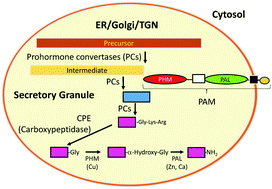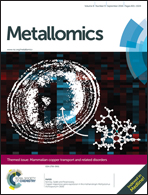Copper, zinc and calcium: imaging and quantification in anterior pituitary secretory granules
Abstract
The anterior pituitary is specialized for the synthesis, storage and release of peptide hormones. The activation of inactive peptide hormone precursors requires a specific set of proteases and other post-translational processing enzymes. High levels of peptidylglycine α-amidating monooxygenase (PAM), an essential peptide processing enzyme, occur in the anterior pituitary. PAM, which converts glycine-extended peptides into amidated products, requires copper and zinc to support its two catalytic activities and calcium for structure. We used X-ray fluorescence microscopy on rat pituitary sections and inductively coupled plasma mass spectrometry on subcellular fractions prepared from rat anterior pituitary to localize and quantify copper, zinc and calcium. X-ray fluorescence microscopy indicated that the calcium concentration in pituitary tissue was about 2.5 mM, 10-times more than zinc and 50-times more than copper. Although no higher than cytosolic levels, secretory granule levels of copper exceeded PAM levels by a factor of 10. Atp7a, which transports copper into the lumen of the secretory pathway, was enriched in endosomes and Golgi, not in secretory granules. If Atp7a transfers copper directly to PAM, this pH-dependent process is likely to occur in Golgi and endosomes.

- This article is part of the themed collection: Mammalian Copper Transport and Related Disorders

 Please wait while we load your content...
Please wait while we load your content...